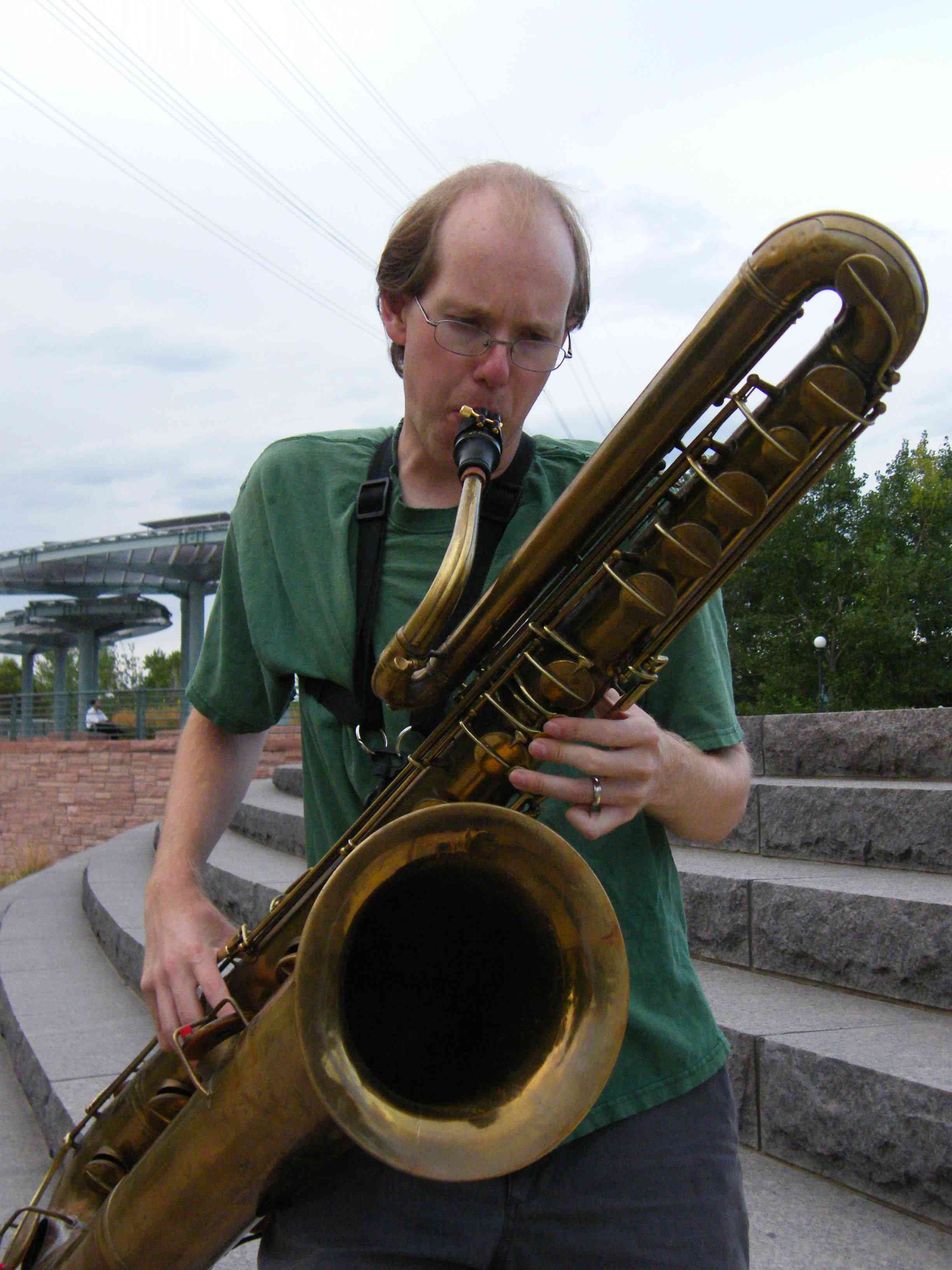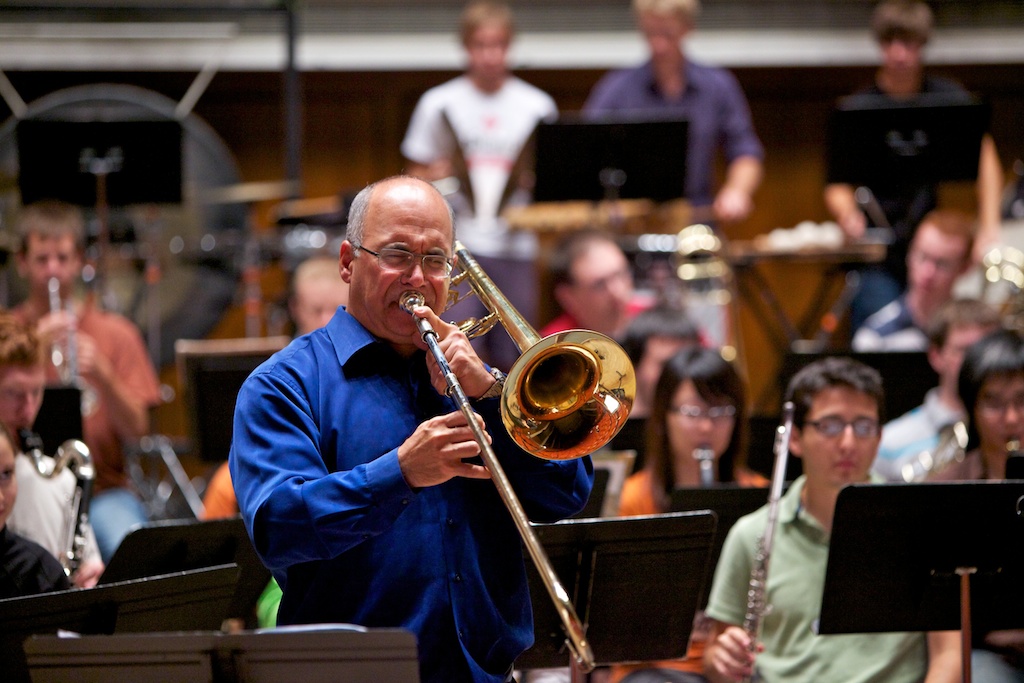April 17, 2012
Harvest at Cabrillo
I am over-the-top excited to finally share the news that this summer, Joseph Alessi (Principal Trombone, New York Philharmonic) will perform my concerto, “Harvest,” at the Cabrillo Festival of Contemporary Music, conducted by Marin Alsop.
Q: Wait, what? How? Cabrillo is a big-time orchestra festival. Isn’t “Harvest” a… a band piece?
A: No. Well, yes and no. It was commissioned by a consortium of military and university bands, and premiered by the West Point Band, but it’s not scored for traditional wind ensemble. It’s scored for “orchestra without strings.”
Q: What the hell does that even mean? What’s the difference between “wind ensemble” and “concert band” and “orchestra without strings?”
A: “Wind ensemble” is the fancy-pants name for “band,” and it traditionally means one player per part, with maybe a couple of exceptions like an extra clarinet or two. “Concert band” implies (to me, at least) that doubling can happen relatively freely, so you might have three people playing 1st trumpet, a total of 6 or more trombones (sharing 3 or 4 parts), a clarinet section with a dozen players (but only 3 different parts), etc. A wind ensemble or band or concert band or symphonic band or wind orchestra — or whatever we call it — normally includes a sax section, a euphonium (or several), and a whole bunch of percussionists. An orchestra doesn’t traditionally contain saxes or euphoniums, and usually only has 3-4 percussionists. Orchestras don’t double up on individual parts (other than strings), so if there are three clarinet parts, there will only be three clarinet players. An “orchestra without strings,” then, is a “wind ensemble” with no doubling instruments, no saxes, no euphonium, and only 3-4 percussionists.
Q: But this was commissioned by a bunch of bands. Why’d you write it for “orchestra without strings?” What about the saxes? Do you hate saxes?
A: No. Clearly no. I love saxes. I have a big ol’ soprano sax concerto, and my wind ensemble works feature a lot of saxophone. I’m currently writing a piece for saxophone quartet! But the thinking with “Harvest” was that a smaller “orchestra without strings” ensemble would help avoid balance issues that might arise in a concerto accompanied by a standard wind ensemble; the scoring could be more transparent, but still be capable of being very loud; and without saxes to depend on, I’d probably write more interesting parts for the double reeds. Plus, because “Harvest” was commissioned for Joe Alessi, the Principal Trombonist of the New York Philharmonic — a player who solos and records with other orchestras all over the world — I wanted him to be able to play my piece with bands or with orchestras. Honestly, the remote possibility of a professional orchestra performance was very appealing.
Q: That sounds like a long shot, though. I mean, why would an orchestra program one of your pieces anyway? Last I heard, you aren’t dead. You know what orchestras say: The best composer is a dead composer.
A: Yes, it was a long shot. I mean, is the New York Philharmonic likely to program “Harvest” – or any of my music? No, but there was no reason, with this piece, to eliminate the possibility. I was hoping that I might have a distant shot at Cabrillo, though.
Q: Yeah, about that. How’d you convince them to program your piece? That’s a badass festival, and they program music by Big Time Composers like John Adams, Jennifer Higdon, John Corigliano, and James MacMillan. Why your piece?
A: That was all Marin Alsop, the Music Director of the festival. I met Marin several years ago when she performed “Redline Tango” (the original version for orchestra) at Cabrillo. It was an amazing couple of days. I really wanted to go back and work with her again, but, in all honesty, I didn’t have any other orchestra pieces that were good enough for her to program. Other than “Redline Tango,” my orchestra music is pretty old, and it’s not great, and I’m not just being modest.
Q: You’re never modest.
A: That wasn’t a question.
Q: Sorry. Go on.
A: Anyway, when I was about to start writing “Harvest,” my brilliant wife, AEJ —
Q: What’s her real name?
A: I’d rather not say. She’s very private.
Q: Is she even a real person? Or is this like one of those, “Oh, you wouldn’t know her. She lives in Canada” things?
A: She’s real. And again: brilliant.
Q: How brilliant could she really be? I mean, she married you. Heh.
A: She got 1580 on her GRE.
Q: Good christ. Okay, she’s brilliant. So, she must think you’re a complete moron.
A: Could we get back to “Harvest” at Cabrillo?
Q: Yeah, you were saying…
A: I was about to write “Harvest,” and AEJ suggested that I should score it for orchestra-without-strings, so that Joe Alessi (or other trombonists) could play it with orchestras or bands. So I emailed Marin Alsop and told her that I was about to write a concerto for Joe Alessi. They’d worked together in the past, and they’d even recorded the Pulitzer Prize-winning trombone concerto of Christopher Rouse. I thought that maybe, if offered a new chance to collaborate with Joe, Marin would think that sounded fun, and the possibility of working with him would outweigh the fact that I was the shlub writing the piece.
Q: So you just emailed her and asked her to program a concerto you hadn’t even started?
A: Good lord no. I’m very scared of Marin Alsop.
Q: Is she scary?
A: No. I’m just a coward, and I have a fear of powerful orchestral conductors. And water sports. And some dogs. I’m kind of scared of dogs.
Q: So what did you say in the email?
A: I just told her that I was about to write this concerto for Joe Alessi, and I was going to score it for orchestra without strings. I asked her if I could send it to her when it was done. She was very kind, and replied saying that yes, she’d like to see it, and that she loved working with Joe Alessi in the past, and to tell him hello.
Q: That was it?
A: I also emailed her to ask her if I should score it for triple winds or quadruple winds — that is, 3 flutes or 4, 3 clarinets or 4, etc. A standard orchestra has 3 of each, but I didn’t know if I could get away with 4. She replied “stick with 3,” so I started writing the piece with triple winds. Well, mostly. It’s three flutes plus a piccolo, and 3 clarinets plus a bass clarinet. But in a pinch, you could do it with true triple winds.
Q: And what happened next?
A: I finished it, it premiered, and as soon as I had the full, mastered recording — this was in December 2010 — I contacted Marin once more and asked her if she’d look at it.
Q: And you were like, “you should do it at Cabrillo!”
A: Of course not. I just asked if she’d give the piece a look. She sent a very nice reply — really, I don’t know why I’m still scared of her, but I am — and asked me to send it along. I packed it up, mailed it out, and three days later, she sent an email saying she wanted to do it at Cabrillo.
Q: That’s awesome. Did you send it to any other orchestra conductors?
A: No. I’ve sent other pieces to other orchestra conductors in the past – I sent “Redline Tango” to over a dozen conductors – and it proved to be a waste of time and money. Your piece ends up in a towering stack of other unsolicited scores – I saw it for myself when I worked for a major orchestra for a year after college – and nobody will ever listen to your piece. I’ve said before that orchestras don’t have much interest in living composers. Marin Alsop and Cabrillo are a rare exception.
Q: So I should send all of my music to Marin Alsop?
A: No, not unless she asks you for it. She first learned of “Redline Tango” not because I sent it blindly, but because Fran Richard at ASCAP, plus my former teacher John Corigliano, both told her about it. I had two people she respected vouching for the piece. I can’t say enough about how important that was.
Q: So, back to “Harvest” at Cabrillo. They actually got Joe Alessi as the soloist? Did Joe know you were trying to book him to play your piece?
A: I’d told him that I wanted to send the piece — and his recording — to Marin, hoping she might program it with him, and he was definitely on board with that, since he’d had great collaborations with her in the past. I think he had to shift some things around in his schedule to make Cabrillo work when they actually asked him, but the festival booked him, and programmed the piece for the final day of the 50th anniversary of the festival.
Q: You mean the grand finale concerts at the Mission San Juan Bautista?
A: Yes!
Q: But don’t they repeat that concert? They play the same program twice on the same day, right?
A: Yes!
Q: Does that mean that Joe Alessi has to perform your trombone concerto twice in the same day?
A: Yes!
Q: Good thing that dude is the best trombonist ever to walk the earth.
A: Agreed. It’s going to be a good time.
Q: I’m so going to that.
A: See you there.
(Edit: Since originally posting this, the festival has added a performance of “Breakdown Tango” to their “Music in the Mountains” concert on Thursday, August 9.)
(That’s me, the last time I attended Cabrillo, posing for my still-unreleased and unrecorded Christian Rock album cover.)
Comments
comments for this post are closed